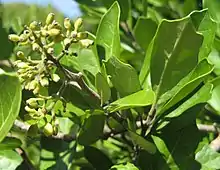Pennantia
Pennantia is the sole genus in the plant family Pennantiaceae. In older classifications, it was placed in the family Icacinaceae.[2] Most authorities have recognised three or four species, depending on whether they recognised Pennantia baylisiana as a separate species from Pennantia endlicheri.[3] British-born botanist David Mabberley has recognised two species.[4]
| Pennantia | |
|---|---|
 | |
| Pennantia corymbosa | |
| Scientific classification | |
| Kingdom: | Plantae |
| Clade: | Tracheophytes |
| Clade: | Angiosperms |
| Clade: | Eudicots |
| Clade: | Asterids |
| Order: | Apiales |
| Family: | Pennantiaceae J.Agardh[1] |
| Genus: | Pennantia J.R.Forst. & G.Forst. |
| Type species | |
| Pennantia corymbosa J.R.Forst. & G.Forst. | |
The species are small to medium, sometimes multi-trunked trees. Leaves are alternate, leathery, and with entire or sometimes toothed margins. Inflorescences are terminal and flowers are functionally unisexual; the species are more or less dioecious.[3]
Pennantia species grow naturally in New Zealand, Norfolk Island, and eastern Australia. In Australia, P. cunninghamii grows across a broad latitudinal natural range (nearly 3,000 km (1,900 mi)), from the south coast of New South Wales northwards through to north eastern Queensland.
The genus name, Pennantia, is in honor of Thomas Pennant, an 18th century Welsh zoologist and author.
Species
The following four species were recognised by New Zealand botanists Rhys O. Gardner and Peter J. de Lange in 2002.[3]
- Pennantia baylisiana, (W.R.B.Oliv.) G.T.S.Baylis – Three Kings Islands
- Pennantia corymbosa J.R.Forst. & G.Forst., 'kaikōmako' – New Zealand
- Pennantia cunninghamii Miers, 'brown beech' – NSW, Qld, Australia
- Pennantia endlicheri Reissek – Norfolk Island
References
- Angiosperm Phylogeny Group (2009). "An update of the Angiosperm Phylogeny Group classification for the orders and families of flowering plants: APG III" (PDF). Botanical Journal of the Linnean Society. 161 (2): 105–121. doi:10.1111/j.1095-8339.2009.00996.x. Retrieved 2013-07-06.
- Kårehed, Jesper (2003). "The family Pennantiaceae and its relationships to Apiales". Botanical Journal of the Linnean Society. 141 (1): 1–24. doi:10.1046/j.1095-8339.2003.00110.x.
- Gardner, Rhys O.; de Lange, Peter J. (2002). "Revision of Pennantia (Icacinaceae), a small isolated genus of Southern Hemisphere trees". Journal of the Royal Society of New Zealand. 32 (4): 669–695. doi:10.1080/03014223.2002.9517715. S2CID 83782970.
- Mabberley, David J. (2008). Mabberley's Plant-Book (third ed.). UK: Cambridge University Press.